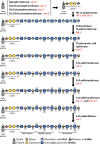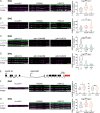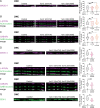Specific heparan sulfate modifications stabilize the synaptic organizer MADD-4/Punctin at Caenorhabditis elegans neuromuscular junctions
- PMID: 33983408
- PMCID: PMC8864735
- DOI: 10.1093/genetics/iyab073
Specific heparan sulfate modifications stabilize the synaptic organizer MADD-4/Punctin at Caenorhabditis elegans neuromuscular junctions
Abstract
Heparan sulfate (HS) proteoglycans contribute to the structural organization of various neurochemical synapses. Depending on the system, their role involves either the core protein or the glycosaminoglycan chains. These linear sugar chains are extensively modified by HS modification enzymes, resulting in highly diverse molecules. Specific modifications of glycosaminoglycan chains may thus contribute to a sugar code involved in synapse specificity. Caenorhabditis elegans is particularly useful to address this question because of the low level of genomic redundancy of these enzymes, as opposed to mammals. Here, we systematically mutated the genes encoding HS modification enzymes in C. elegans and analyzed their impact on excitatory and inhibitory neuromuscular junctions (NMJs). Using single chain antibodies that recognize different HS modification patterns, we show in vivo that these two HS epitopes are carried by the SDN-1 core protein, the unique C. elegans syndecan ortholog, at NMJs. Intriguingly, these antibodies differentially bind to excitatory and inhibitory synapses, implying unique HS modification patterns at different NMJs. Moreover, while most enzymes are individually dispensable for proper organization of NMJs, we show that 3-O-sulfation of SDN-1 is required to maintain wild-type levels of the extracellular matrix protein MADD-4/Punctin, a central synaptic organizer that defines the identity of excitatory and inhibitory synaptic domains at the plasma membrane of muscle cells.
Keywords: C. elegans; 3-O-sulfotransferase; MADD-4/Punctin; heparan sulfate modification enzymes; heparan sulfate proteoglycan; synapse; synaptomatrix; syndecan.
© The Author(s) 2021. Published by Oxford University Press on behalf of Genetics Society of America. All rights reserved. For permissions, please email: journals.permissions@oup.com.
Figures







Similar articles
-
The HSPG syndecan is a core organizer of cholinergic synapses.J Cell Biol. 2021 Sep 6;220(9):e202011144. doi: 10.1083/jcb.202011144. Epub 2021 Jul 2. J Cell Biol. 2021. PMID: 34213535 Free PMC article.
-
C. elegans Punctin specifies cholinergic versus GABAergic identity of postsynaptic domains.Nature. 2014 Jul 24;511(7510):466-70. doi: 10.1038/nature13313. Epub 2014 Jun 1. Nature. 2014. PMID: 24896188
-
Combinatorial roles of heparan sulfate proteoglycans and heparan sulfates in Caenorhabditis elegans neural development.PLoS One. 2014 Jul 23;9(7):e102919. doi: 10.1371/journal.pone.0102919. eCollection 2014. PLoS One. 2014. PMID: 25054285 Free PMC article.
-
Heparan sulfate proteoglycans in Drosophila neuromuscular development.Biochim Biophys Acta Gen Subj. 2017 Oct;1861(10):2442-2446. doi: 10.1016/j.bbagen.2017.06.015. Epub 2017 Jun 20. Biochim Biophys Acta Gen Subj. 2017. PMID: 28645846 Review.
-
The genetics of synapse formation and function in Caenorhabditis elegans.Cell Tissue Res. 2006 Nov;326(2):273-85. doi: 10.1007/s00441-006-0277-2. Epub 2006 Aug 3. Cell Tissue Res. 2006. PMID: 16896949 Review.
Cited by
-
Visualizing and quantifying molecular and cellular processes in Caenorhabditis elegans using light microscopy.Genetics. 2022 Jul 30;221(4):iyac068. doi: 10.1093/genetics/iyac068. Genetics. 2022. PMID: 35766819 Free PMC article. Review.
-
Loss of the Extracellular Matrix Protein DIG-1 Causes Glial Fragmentation, Dendrite Breakage, and Dendrite Extension Defects.J Dev Biol. 2021 Oct 7;9(4):42. doi: 10.3390/jdb9040042. J Dev Biol. 2021. PMID: 34698211 Free PMC article.
-
Neural Tissue Homeostasis and Repair Is Regulated via CS and DS Proteoglycan Motifs.Front Cell Dev Biol. 2021 Aug 2;9:696640. doi: 10.3389/fcell.2021.696640. eCollection 2021. Front Cell Dev Biol. 2021. PMID: 34409033 Free PMC article. Review.
References
-
- Ai X, Do A-T, Kusche-Gullberg M, Lindahl U, Lu K, et al. 2006. Substrate specificity and domain functions of extracellular heparan sulfate 6-O-endosulfatases, QSulf1 and QSulf2. J Biol Chem. 281:4969–4976. - PubMed
-
- Bülow HE, Hobert O.. 2004. Differential sulfations and epimerization define heparan sulfate specificity in nervous system development. Neuron. 41:723–736. - PubMed
Publication types
MeSH terms
Substances
Grants and funding
LinkOut - more resources
Full Text Sources
Other Literature Sources
Research Materials

